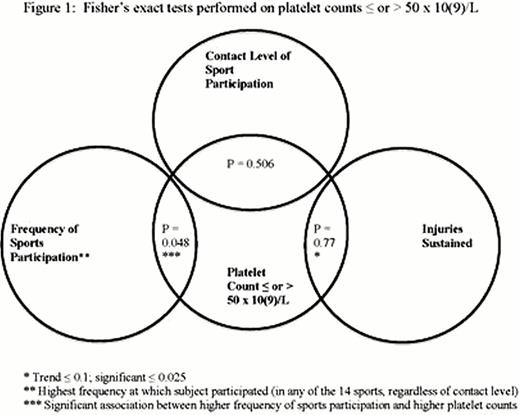Abstract
Abstract 3339
Children with ITP are at risk for bleeding. ITP is one of many conditions for which the American Academy of Pediatrics advises a pre-sports participation evaluation to assess the risk of injury (Rice 2008). However, restrictions in sports participation might deny the many evidence-based benefits of such physical activity usually accessible for US school-aged youth, thereby presenting significant health and quality of life issues. Aims: To better assess the frequency of sports participation and sports-related injury outcomes relative to contact level by gathering data via questionnaire from a convenience sample of children with persistent and chronic ITP.
Fourteen different types of sports activities were included in this IRB-approved questionnaire and were classified as contact, limited contact, or non-contact as determined by the American Academy of Pediatrics Council on Sports Medicine and Fitness (Rice 2008). Questions were aimed at the frequency of sports participation, types of sports played, sports-related injuries (including bleeding), medical care required for injuries, and comfort regarding continued participation in a sport after sustaining an injury. For each sport not played, questions assessed reasons for the subject's decision to refrain from participation. Patients were categorized according to their platelet levels: counts ≤ 50, 50–150, >150; counts ≤ or >50; counts ≤ or >30 (×109/L). Proportions of data involving 2 groups were compared in a contingency table using Fisher's exact test with trends ≤ 0.01 and significance ≤ 0.025.
Twelve subjects (19%) did not participate in any sports. Thirty-six (56%), including patients across all platelet counts, participated in at least one contact sport. There was no statistically significant association (p > 0.1) between the subject's platelet count and the contact level of sport chosen to play. However, a significant association was found between higher frequency of sports participation and higher platelet count (analyzed by groups ≤ or >50 and counts ≤ or >30 (×109/L)) when the highest frequency of participation in any sport (regardless of contact level) was assessed (p < 0.025). When only the sport with the highest contact rating was considered, patients with higher counts played their highest contact sport more frequently than did those patients with lower counts. In particular, subjects with counts ≤ 30 ×109/L played their highest contact sport less frequently, eg more commonly < 1x/month, compared to subjects with platelet counts > 30 ×109/L who played more commonly > 1x/month (p=0.025) [figure]. Twenty injuries were recorded across 10 different sports and 17 patients, but no serious bleeding injuries were reported. There was a statistically significant association (p = 0.002) between higher contact levels and greater incidence of injury. However, there was no statistically significant association (p > 0.1) between estimated platelet count at time of injury and the contact level of sport. As recorded by the patients and/or the patients' parents, 26% of general concerns came from physicians, 53% from parents and 21% from patients themselves. Data collected on the participants' personal concerns showed that higher platelet counts were associated with fewer personal concerns being expressed (p < 0.025). However, when each personal concern was analyzed there were no statistically significant trends or associations (p > 0.1) found between any specific concern and platelet count. Across all contact and limited-contact sports, the most frequently expressed concern was that the sport was too dangerous. The most frequently expressed concern for non-contact sports was that the patient was too tired to play.
There was a significant association between higher frequency of sports participation, but not higher contact level, with higher platelet counts. Higher incidences of injury were associated with higher contact levels, but not with lower platelet counts, suggesting that children with ITP can participate in non-contact sports and many contact and limited-contact sports with low risk of injury. Therefore, we believe that sports participation for children with ITP is generally too restricted and greater encouragement for children to be athletic in the sport of their choice is warranted.
Bussel:Sysmex: Research Funding; Shionogi: Membership on an entity's Board of Directors or advisory committees, Research Funding; Eisai: Membership on an entity's Board of Directors or advisory committees, Research Funding; Ligand: Membership on an entity's Board of Directors or advisory committees, Research Funding; Immunomedics: Research Funding; IgG of America: Research Funding; Genzyme: Research Funding; GlaxoSmithKline: Family owns GSK stock, Family owns GSK stock Other, Membership on an entity's Board of Directors or advisory committees, Research Funding; Cangene: Research Funding; Amgen: Family owns Amgen stock Other, Membership on an entity's Board of Directors or advisory committees, Research Funding; Portola: Consultancy.
Author notes
Asterisk with author names denotes non-ASH members.


